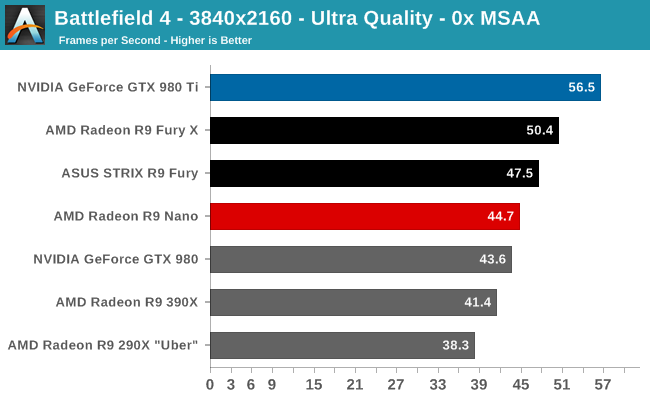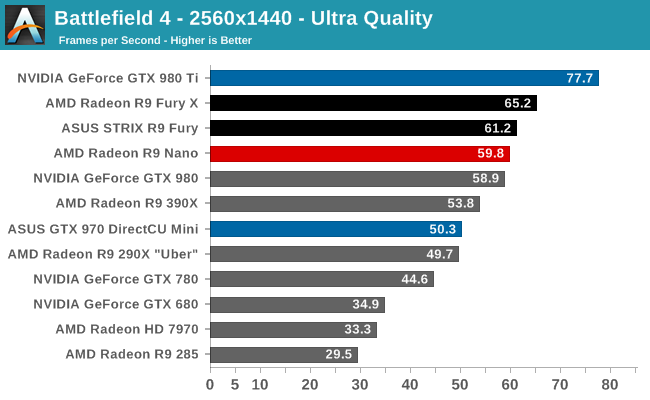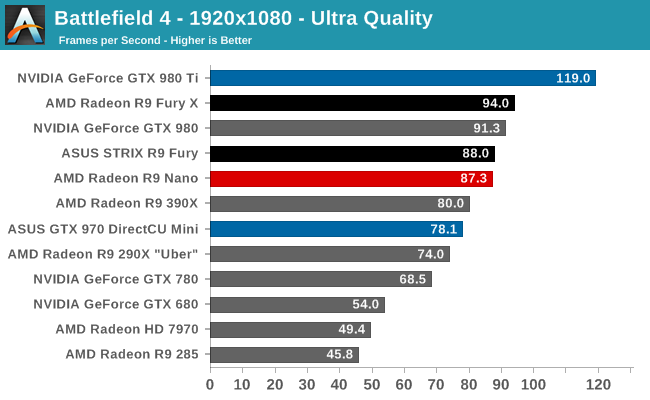The AMD Radeon R9 Nano Review: The Power of Size
by Ryan Smith on September 10, 2015 8:00 AM ESTBattlefield 4
Kicking off our benchmark suite is Battlefield 4, DICE’s 2013 multiplayer military shooter. After a rocky start, Battlefield 4 has since become a challenging game in its own right and a showcase title for low-level graphics APIs. As these benchmarks are from single player mode, based on our experiences our rule of thumb here is that multiplayer framerates will dip to half our single player framerates, which means a card needs to be able to average at least 60fps if it’s to be able to hold up in multiplayer.




Like the other Fiji cards, AMD is promoting the R9 Nano in part on its 4K capabilities. And while we disagree that this card is suitable for 4K gaming based on its sub-Fury performance, we’re including 4K results anyhow to serve as a point of comparison.
In any case Battlefield 4 is often a good indicator of general card performance, and for the R9 Nano this is no exception. What we find is that the R9 Nano trails the other Fury cards in all cases. However to our initial surprise, the R9 Nano sticks rather close to the R9 Fury. The petite powerhouse trails the R9 Fury by only 1-6%, which for the record is a smaller gap than we were expecting.
While the R9 Nano packs a full Fiji GPU, AMD has to pull back on clockspeeds to hit their power targets; in the case of Battlefield 4 this is an average clockspeed of just 879MHz at 2560x1440. Given this we had been expecting the R9 Nano to deliver around 85-90% of the performance of the R9 Fury (and about 80% of the R9 Fury X), based on the assumption that average clockspeeds would be closer to 800MHz. So the fact that the R9 Nano starts off as close to the R9 Fury as it does – even if it’s still trailing it – is a pleasant surprise.
Otherwise with performance still clearly occupying a position as a “3rd tier” Fiji card, I’m not sure if anything about these results should be surprising. On a price/performance basis AMD is not intending to be competitive with other $650 cards, so the R9 Fury X and GTX 980 Ti are of course on the top of the heap. What you get instead is a card that delivers around 90% of R9 Fury X’s performance in BF4 with much less power consumption.
Moving on, compared to the lower power and smaller cards, the R9 Nano is as expected a clean sweep. Demonstrating the virtues of a wide and lower clocked processor’s ability to deliver strong performance without requiring extreme power, everything from the R9 285 to the GTX 980 trails the R9 Nano here. Compared to the GTX 970 Mini in particular, the R9 Nano is 12-26% faster depending on the resolution.
The one potential problem here for the R9 Nano is the GTX 980. Though not a Mini-ITX card, the GTX 980’s power consumption is going to be fairly close to the R9 Nano’s, definitely more so than GTX 970’s. From a power efficiency standpoint it’s the GTX 980 that poses the greatest challenge to the R9 Nano, and while it’s ahead of the GTX 980 in this case at 2560x1440 and higher, it’s a sign that AMD should be worried about what could happen if an NVIDIA partner produced a Mini-ITX GTX 980.










284 Comments
View All Comments
looncraz - Thursday, September 10, 2015 - link
Indeed. At $200 cheaper I'd consider buying two of them, rather than none.The lack of a DL-DVI port, though, would probably limit me to just one.
Alexvrb - Saturday, September 12, 2015 - link
Agreed I think it's a great compact card but for their sake I hope they drop the price gradually as yields improve. Personally I will be waiting to see what happens with HBM2, I'm hoping that with the improvements in density they'll be able to push it into mid-range cards as well next time.Oxford Guy - Thursday, September 10, 2015 - link
I didn't see much about DX 12 and how it should counter all the energy efficiency stuff that is being pretty much obsessed about. The conclusion, for instance, talks so much about energy efficiency when in fact the real point of this card is not performance per watt but the form factor.I don't see anything about Ashes — not even a word about why it wasn't included.
Ryan Smith - Thursday, September 10, 2015 - link
"I don't see anything about Ashes — not even a word about why it wasn't included."We don't include non-release software in our GPU evaluations. Ashes isn't a complete game, it's still an alpha.
AS118 - Thursday, September 10, 2015 - link
I feel like that's totally valid. Until multiple finalized DX12 benches come out, I don't feel that we can really understand how current cards will work with DX12.Oxford Guy - Friday, September 11, 2015 - link
It still merits a mention, even if it's just to say that.AS118 - Thursday, September 10, 2015 - link
I agree. In fact, this review seems as honest as every other Nano one. They all say "it's niche" and "it's too expensive for the performance if you don't need the small size, and regardless of what Roy said, the sites that were given a card are quite critical of the Nano, and most recommend getting a bigger, faster, cheaper card instead if you don't need something tiny.They say "It's a great product, but only for people that really must have the strongest mini-card".
RussianSensation - Thursday, September 10, 2015 - link
Wreckage = trolls like Rollo, but minus the facts.Kutark - Thursday, September 10, 2015 - link
Whats the Roy Taylor incident? Im not aware.at80eighty - Friday, September 11, 2015 - link
If there's anyone championing the cause of objectivity, it's you